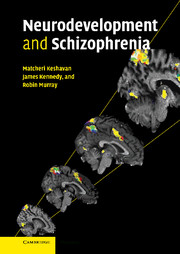
-
Select format
-
- Publisher:
- Cambridge University Press
- Publication date:
- 04 August 2010
- 18 November 2004
- ISBN:
- 9780511735103
- 9780521823319
- 9780521126595
- Dimensions:
- (247 x 174 mm)
- Weight & Pages:
- 1.258kg, 514 Pages
- Dimensions:
- (244 x 170 mm)
- Weight & Pages:
- 0.81kg, 516 Pages
You may already have access via personal or institutional login
Book description
This book was originally published in 2004 and concerns developmental neurobiology. In the decade preceding publication, developmental neurobiology made important strides towards elucidating the pathophysiology of psychiatric disorders. Nowhere has this link between basic science and clinical insights become clearer than in the field of schizophrenia research. Each contributor to this volume provides a fresh overview of the relevant research, including directions for further investigation. The book begins with a section on advances in developmental neurobiology. This is followed by sections on etiological and pathophysiological developments, and models that integrate this knowledge. The final section addresses the clinical insights that emerge from the developmental models. This book will be valuable to researchers in psychiatry and neurobiology, students in psychology, and all mental health practitioners.
Reviews
Review of the hardback:'… an excellent book that delivers a scientific map of recent neurodevelopmental concepts.'
Source: British Journal of Neuroscience Nursing
Review of the hardback:'… a well-balanced and comprehensive overview that merits to be read by all students of this fascinating and devastating disorder.'
Source: Genes, Brain and Behaviour
Contents
Metrics
Full text views
Full text views help Loading metrics...
Loading metrics...
* Views captured on Cambridge Core between #date#. This data will be updated every 24 hours.
Usage data cannot currently be displayed.
Accessibility standard: Unknown
Why this information is here
This section outlines the accessibility features of this content - including support for screen readers, full keyboard navigation and high-contrast display options. This may not be relevant for you.
Accessibility Information
Accessibility compliance for the PDF of this book is currently unknown and may be updated in the future.


